Ahsan A. (ed.) Evaporation, Condensation and Heat transfer
Подождите немного. Документ загружается.


Fundamentals of Paper Drying – Theory and Application from Industrial Perspective
539
and dry bulb temperatures are known. Alternatively, it can be calculated from the partial
vapour pressure of water in the air from the following equation:
()
wa
H M p / M * P p
⎡
⎤
=−
⎣
⎦
(3)
where
H absolute humidity, H
2
O/kg dry air
p partial vapour pressure, kPa
P barometric pressure, kPa
M
w
Molecular weight of water: 18.02
M
a
Molecular weight of air: 28.97
If relative humidity and temperature values are known, the absolute humidity can also be
calculated using the following equation:
()
H 0.00620689 * RH * p / 1 .01 * RH * p=−
(4)
where
H Absolute humidity, H
2
O/kg dry air
p partial vapour pressure, kPa and can be calculated using equation (1)
RH
relative humidity, %
2.1.4 Sorption isotherm
Due to hygroscopic nature of paper, partial vapour pressure at the web surface or anywhere
inside the web is a function of local temperature and moisture content. A correlation
between relative humidity and the equilibrium moisture content at a constant temperature
is a sorption isotherm. Equilibrium moisture content at a certain relative humidity gives
slightly different values depending on whether the equilibrium is approached through
wetting of initial dry materials (adsorption) or through drying (desorption). This
phenomenon is called hysteresis.
The sorption isotherm of paper depends on the type of fibres that have been used to
manufacture the paper. Various correlations for sorption isotherms are available in the
literature (Karlsson et al.,, 1993; Lampinen and Toivonen, 1984). The following one is best
suitable for mechanical pulp (Heikkila, 1993):
24
13
{( ) ( )}
1
CC
CZ CTZ
e
ρ
−+
=−
(5)
where
C
1
= 47.58; C
2
= 1.877; C
3
= 0.10085/
o
C; C
4
= 1.0585
ρ Relative Humidity of air inside chamber/room/store ;
ρ*100 Relative Humidity, %
Z Equilibrium Moisture Ratio; Z*100 = Moisture Uptake, %
T Temperature,
o
C
Graphical representation of equation (5) is shown in Figure 2.1.
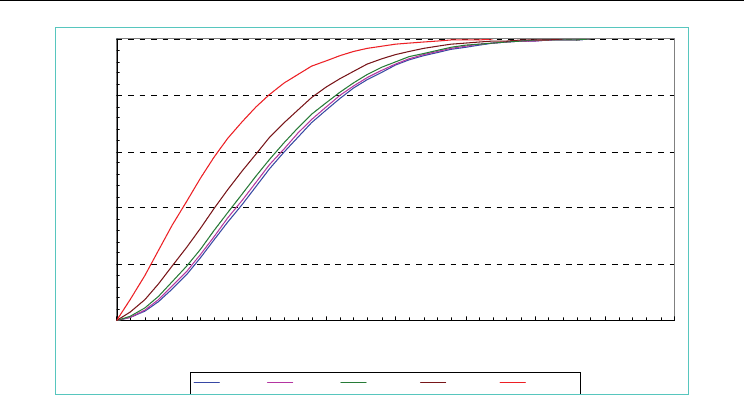
Evaporation, Condensation and Heat Transfer
540
0.0
0.2
0.4
0.6
0.8
1.0
0.00 0.05 0.10 0.15 0.20 0.25 0.30 0.35 0.40
Moisture Ratio, g/g
Relative Humidity
2 Deg C 5 Deg C 10 Deg C 30 Deg C 90 Deg C
Fig. 2.1 Figure 16 Moisture Uptakes vs. Relative Humidity at Various Temperatures
2.1.5 Heat transfer
In paper drying the predominant mode of heat transfer is by conduction for manufacturing
majority of paper grades. Convective heat transfer also play significant role in dryer pocket
ventilation system. For tissue grades where hot air impingement on the web is applied, heat
transfer by convection is most important. Radiation heat transfer is usually ignored in
conventional paper drying since its contribution to the overall heat transfer is much less
than that due to conduction and convection.
The basic form for one dimensional steady state heat conduction is shown in equation (6),
while that of convective heat transfer is shown in equation (7). :
Q kA T / X=ΔΔ (6)
Q hA T=Δ (7)
where
Q heat transfer rate, J/s (W)
k thermal conductivity, W/m.K
A heat transfer surface area, m
2
T Temperature, K
X diameter or thickness, m
H heat transfer coefficient, W/m
2 o
C
The rate of conduction heat transfer is directly proportional to the thermal conductivity k of
the material and to the temperature gradient, ΔT/ΔX. Heat transfer coefficients depend on
both the physical properties of the fluid and the flow conditions. In paper drying, forced
convective heat transfer occurs at the interface between steam and condensate in the
cylinder, and between paper and air outside the cylinder. The type of flow is turbulent. The
evaluation of heat transfer is difficult. Convective heat transfer is regarded as the flow of a
fluid and dimensional analysis is used to characterize heat transfer coefficient, h. The
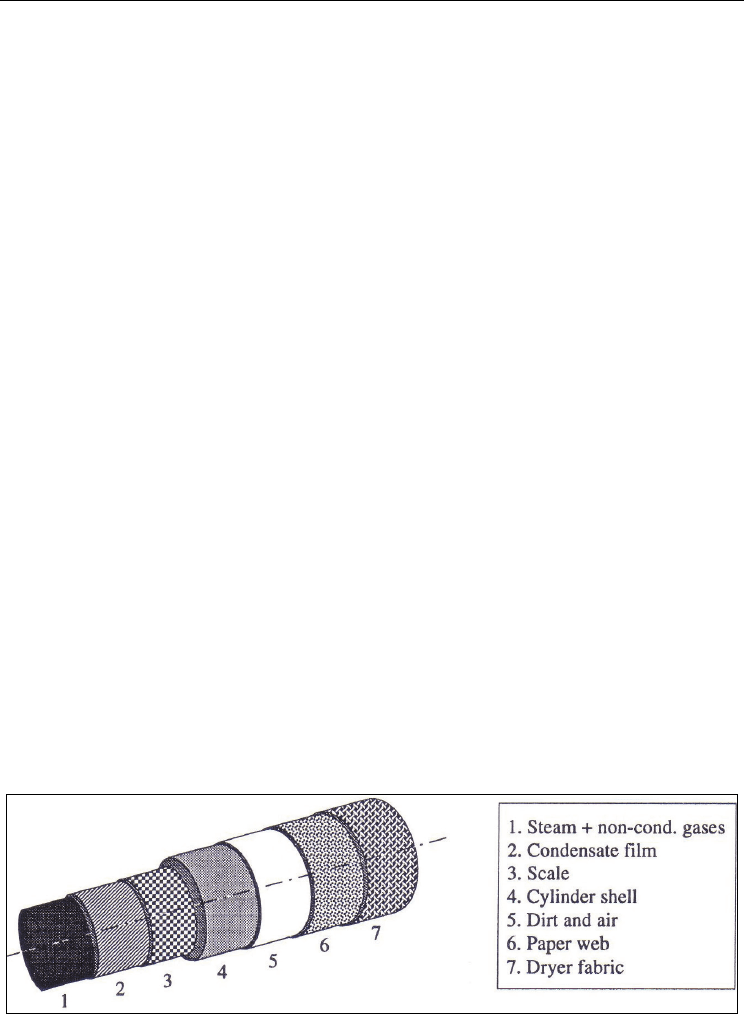
Fundamentals of Paper Drying – Theory and Application from Industrial Perspective
541
parameters involved in convection may be grouped into three dimensionless numbers; the
Nusselt number, the Reynolds number and the Prandlt number. These are defined as:
Nusselt number Nu hD /k== (8)
Reynolds number Re DV==
ρ
/
μ
(9)
p
Prandlt number Pr C /k==
μ
(10)
where
h thermal conductance
D characteristic dimension, e.g. diameter
k thermal conductivity of fluid
V fluid velocity; μ fluid viscosity
C
p
specific heat of fluid; ρ density
2.1.5.1 Heat transfer resistance
Heat is transferred from high temperature areas to the low temperature areas. The rate of
heat transferred from the hot steam inside the cylinder to the cooler paper on the outside
depends on the overall temperature gradient and on the different resistances to heat
transfer:
()
sp
Q UA T T=− (11)
Where
Q rate of heat flow from inside dryer to paper
U overall heat transfer coefficient
T
s
steam temperature
T
p
paper temperature
Figure 2.2 shows the different heat and mass transfer resistances involved when the paper
web is in contact with the cylinder. Modeling of paper drying process is a matter of
describing correctly the transport mechanisms involved. The most crucial and certainly
most difficult issue is to obtain correct transport coefficients.
Fig. 2.2 Cut-way drawing of a dryer cylinder illustrating heat and mass transfer resistance.

Evaporation, Condensation and Heat Transfer
542
The resistance due to scaling inside the cylinder could be lumped together as resistance due
to dryer shell. The various resistances to heat flows are shown in Table 2.1.
Source of resistance Heat flow, q
i
(driving force/resistance)
Steam film
12
1
1
()
1
()
s
TT
q
Ah
−
=
Condensate layer
23
2
2
()
()
c
TT
q
Lc
Ak
−
=
Dryer shell
34
3
3
()
()
s
s
TT
q
L
Ak
−
=
Contact resistance
45
4
4
()
1
()
k
TT
q
Ak
−
=
Paper
56
5
5
()
()
p
p
TT
q
L
Ak
−
=
Air film
67
6
6
()
1
()
a
TT
q
Ak
−
=
Table 2.1 Sources of heat transfer resistance and heat flow
Where
A Area
h thermal conductive conductance
k thermal conductivity
L length
Since under the steady state conditions heat transferred through each layer is the same, all
q’s are equal. The heat flow is equal to the total driving force divided by the total resistance,
therefore:
i
i
T
q
R
Δ
=
∑
∑
(12)
qUAT=Δ (13)
where
12
1
1/ / .... 1/
scc a
U
hA L kA hA
=
+++
(14)
It is evident from equation (11) that the amount of heat transferred may be increased by
increasing U (reduce condensate layer inside cylinder, eliminate non-condensibles, increase
felt tension, increase contact area of felt, increase contact felt permeability, ensure dryer
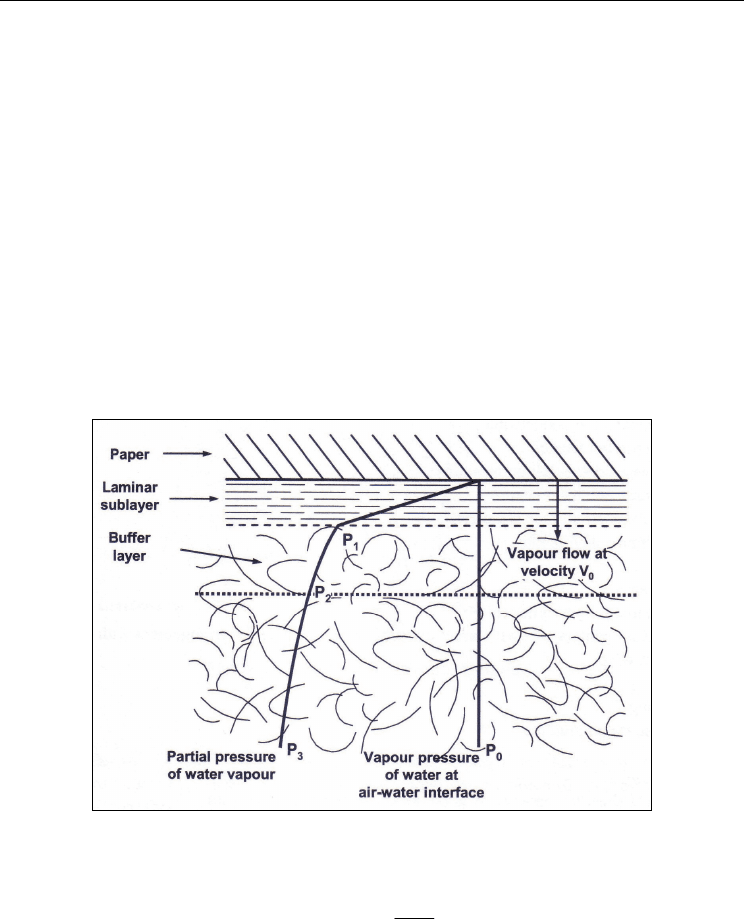
Fundamentals of Paper Drying – Theory and Application from Industrial Perspective
543
surface is clean, optimal shell thickness) ; increasing A (add more dryer cylinders, increase
contact area with larger diameter dryer or single tier arrangement with larger sheet wrap);
increasing T
s
(raise steam temperature) and decreasing T
p
(lower sheet temperature by good
pocket ventilation).
2.1.6 Mass transfer
In paper drying, mass transfer occurs after a sufficient amount of heat energy has been
transmitted to the web, resulting in the transfer of mass of water from the paper to the air in
the dryer section. The driving force for mass transfer is a concentration (or partial pressure)
difference between two points. Mass transfer of water can occur by three different modes:
molecular diffusion, convective or eddy diffusion and bulk movement or ventilation.
The mass transfer occurring in paper drying can be described as molecular diffusion. Water
is transferred from the moist paper surface through a boundary layer of air. Convective
mass transfer involves this molecular diffusion through a laminar sub layer, a combination
of molecular diffusion and turbulent mixing through a buffer layer, and turbulent mixing
with the main body of air in a turbulent boundary layer. The process of convective mass
transfer is shown in Figure 2.3.
Fig. 2.3 Mass Transfer at web-air interface
The rate of molecular diffusion is described by Fick’s law:
A
Av
dC
MD
dx
=−
(15)
Where
M
A
mass transfer of A per unit area, kg/hr.m
2
D
v
molecular diffusivity (area/time)
C
A
concentration of A
x distance

Evaporation, Condensation and Heat Transfer
544
For water vapour diffusing from the paper into the surroundings, this concentration
gradient is expressed as a partial pressure difference:
()
A
g
ol
M kP– P= (16)
Where
k
g
mass transfer coefficient
P
o
partial pressure of water at sheet surface
P
l
partial pressure of water in surrounding air
Similar to heat transfer, dimensional analysis and experimental evaluation can be used to
determine the transfer coefficient. Although k
g
can be determined experimentally, for
practical uses convective mass transfer can be expressed in the general form:
()
pa
M KA P – P= (17)
Where
M rate of evaporation
K overall mass transfer coefficient
A evaporation area
P
p
vapour pressure of water in the paper
P
a
vapour pressure of water in surrounding air
The overall mass transfer coefficient K is a function of diffusivity within the web and
convective air flow in the dryer pocket. Often, the air near the centre of the dryer pocket is
more humid than the air at the pocket edges, which gives to non-uniform evaporation rates.
Pocket ventilation with warm dry air is used to correct this situation. From the general mass
transfer equation it can be seen that the evaporation rate can be maximized by increasing K
(reduce the boundary layer of air using pocket ventilation), increasing A (increase the
evaporation area), increasing P
p
(the vapour pressure of water in the sheet can be increased
by sheet temperature) and decreasing P
a
(the vapour pressure in the air can be decreased by
lowering the humidity through pocket ventilation and/or dryer design).
3. Paper drying principles and web structure
As the paper web leaves the press section of a paper machine, considerably more than half
of its weight is water. This water must be removed in the dryer section of the paper machine
to the level between 6% and 8% of final water content, before the paper can be suitably used.
The removal of water by use of steam heated cylinder, in spite of high capital investment
and running cost, is an efficient process. Recent attempts to develop new drying methods
other than cylinder drying have targeted to achieve higher drying efficiency, with improved
functional properties of finished products. However, such methods are yet to be accepted in
commercial paper manufacturing. It appears likely that new paper machines will
incorporate multi-cylinder drying for many years to come.
3.1 Drying phases
During the drying process, wet paper passes through three distinct phases before exiting as
a dry sheet. Figure 3.1 shows the different phases: warm-up (period AB), constant rate
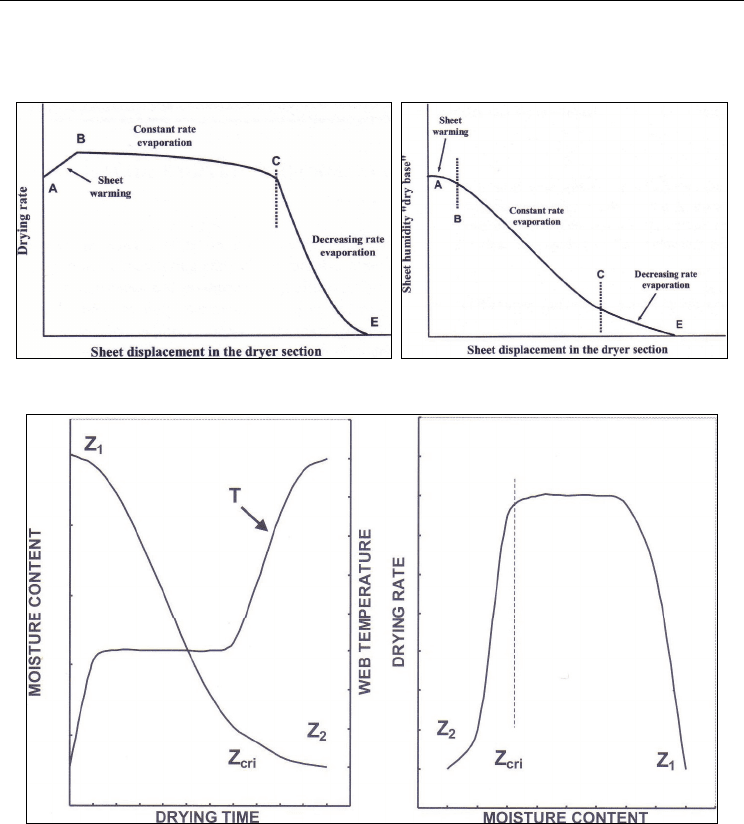
Fundamentals of Paper Drying – Theory and Application from Industrial Perspective
545
evaporation (period BC) and falling-rate evaporation (period CE). This idealized scheme
occurs if drying conditions are similar over the entire drying process. In commercial dryers,
the constant rate phase does not often exist.
Fig. 3.1 Different drying phases (Karlsson 1995).
Fig. 3.2 Different drying phases and critical moisture (Karlsson 1995).
Near the end of period AB, an equilibrium between heat transfer to the sheet and
evaporation from the sheet surface is reached. This is the beginning of the constant rate
period of evaporation, which continues as long as there is free water at the sheet surface. As
drying progresses, the waterfront recedes into the sheet, the amount of free water
diminishes and capillary forces begin to become important, resulting in changes in sheet
and fibre structure. The diffusion of water vapour in the sheet, the decreasing thermal
conductivity of the sheet, stronger water-to-fibre bonds, and higher contact resistance
between the sheet and the drying cylinder all lead to a reduction in the drying rate once the
sheet reached certain moisture content. As a result of decreasing drying rate, the energy

Evaporation, Condensation and Heat Transfer
546
used for evaporation also decreases. Web temperature begins to rise when the system tries
to find a thermal balance. The inversion point between the constant and falling rate phases
is the critical moisture content (shown by Z
cri
in Figure 3.2).
3.2 Change in web structure during drying
The heat and mass transfer phenomena inside the paper web during drying is considerably
influenced by the structure of the network formed by the fibres, liquid water and gas filled
pores. Parameters such as volume fractions of different compounds, continuity and
tortuosity of the flow paths, and pore size distribution can describe the structure. Web
structure after the press section is the initial point where moisture content and web density
are significant parameters. Web structure develops in the dryer section when water
gradually departs and the volume originally filled with water becomes partly substituted
with gas and partly compensated through shrinkage of the web. Paper shrinks during
drying in the direction of thickness and in the plane. On the paper machine, the paper web
has strains in the machine direction. The web can partially shrink in the cross direction.
Shrinkage is typically 30%-40% and 1%-10% in plane.
The path through which the evaporated water escapes during drying is tortuous. The
tortuosity changes as the paper dries until reaching the final moisture content and thickness.
The pores opening at the paper surface are not necessarily perpendicular to the surface.
Vapour finds its way from the paper surface along the path with least resistance.
3.3 Flow of free and bound water
Water present in a moist paper consists of free and bound water. The free water is between
the fibres and in large pores (macro pores), while the bound water is in the micro pores at
the amorphous region in the cell wall and in accessible hydrophilic groups (Weise, 1997).
The thermodynamic and physical properties of free and bound waters in moist web are
different, the melting properties of free water being same as that of bulk water. Drying
decreases the level of fibre swelling by closing the pores in a fibre cell wall irreversibly. An
essential factor describing the state of fibre is the fibre saturation point (FSP). This expresses
the amount of water within the fibre cell wall FSP differs to different pulps and is typically
0.7-1.8.
Capillary flow characterizes the flow of liquid water in a paper web, as long as it forms a
continuous phase. Such flow for free water can be expressed by Darcy’s equation:
c
ev
w
dp
m
K
Ady
ρ
μ
= (18)
Where
m
ev
mass flow rate of evaporation
A area
ρ
w
water density
K permeability
μ water viscosity
dp
c
/dy capillary pressure gradient
The driving force for this flow is a gradient in capillary pressure or capillary suction that
results from the moisture gradients in the web. Moisture gradients form in the web due to

Fundamentals of Paper Drying – Theory and Application from Industrial Perspective
547
evaporation from the open surface of the web due to water vaporization at the interface
where the wet web presses against a hot dryer surface and the formed water vapour
diffuses towards inner parts of the web.
When moisture content of the web decreases, the water phase gradually looses its continuity
and splits into separate areas between which liquid flow is not possible anymore. Capillary
flow of free water ends totally when moisture content falls below the fibre saturation point
and all moisture is in the form of bound water. Bound water present in the micropores is
adsorbed on the inner and outer surface of fibre wall as mono or multi-molecular layers. The
first layer of water molecules closest to the surface is very strongly bound and has only
limited mobility. The molecular movement along these layers is surface diffusion or
diffusion of bound water. The driving force for this mass transfer mechanism is a gradient in
concentration of bound water. Similar to capillary flow of free water, the movement of
bound water can be expressed by similar equation:
bw bw
bw d
mdz
D
Ady
ρ
= (19)
Where
m
bw
mass flow rate of bound water
A area;
ρ
d
= dry material density
D
bw
diffusivity of bound water
The diffusivity constant, D
bw,
decreases sharply with decreasing moisture content and
increases with increasing temperature.
4. Multicylinder drying and dryer configuration
Use of steam as the main source of heat energy and the surface of rotating cylinder as the
heat transfer area is the most common method of drying wet web to the finished products.
Almost all paper machines around the globe manufacturing paper and paperboard use
conventional steam heated cylinders or multi-cylinder drying configuration. Besides it
providing good energy efficiency, cylinder drying enables supported web transfer,
facilitates the web transport forward, and improves web smoothness. Cylinder drying also
provides a means to prevent some web shrinkage in cross and machine directions.
Most drying cylinders of paper machines are made of cast iron due to higher thermal
conductivity compared to stainless steel (47 vs. 16 W/m
o
C). The dryer ends or heads are
also made of cast iron. The heads are bolted to the dryer shell at the ends of the dryer.
Figure 4.1 shows a sectional view of dryer cylinder that includes all of its components such
as steam supply and condensate exhaust devices. The most common dryers are 1.5 m and
1.8 m diameter. Shell thickness can vary, but 20-40 mm is common with a pressure rating as
high as 1000 kPa.
4.1 Configuration of multicylinder dryers
Generally all multi-cylinder dryers are configured either two-tier or single tier. Two-tier
configuration is the most common. Such system is continuing since the beginning of paper
drying using steam heated cylinder more than 100 years ago. Use of single tier configuration
has been commercially introduced in late 1970. In all paper machines that have single tier
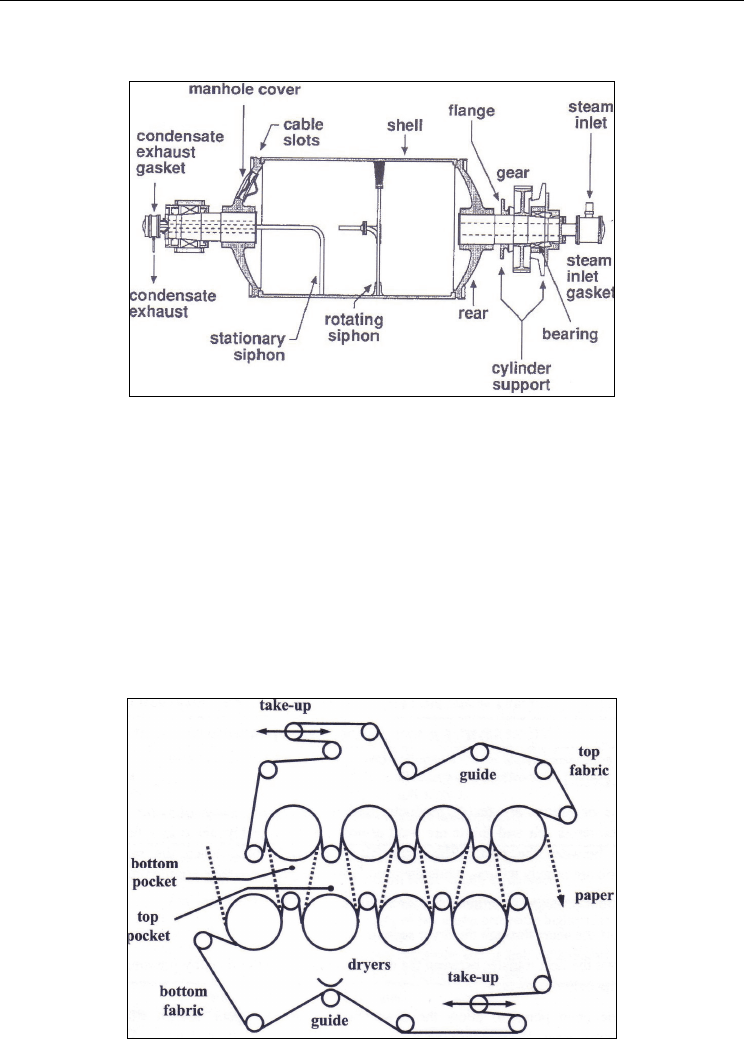
Evaporation, Condensation and Heat Transfer
548
dryer cylinders also have two-tier cylinder, normally in the later part of the dryer section to
avoid single sided appearance of the finished products.
Fig. 4.1 Sectional view of a dryer cylinder
A multi-cylinder dryer section consists of cylinder groups each having its own felting and
drive system. Most paper machines have 5-7 independently driven cylinder groups. Each
group comprises of several dryer cylinders and has variable speed control to maintain sheet
tension between the groups and adjust to any machine direction sheet shrinkage that can
occur. The two-tier configuration has two rows of steam heated cylinders and could be
single or double felted. The double felted configuration is the so-called conventional system
where all the cylinders participate in evaporation. The major disadvantage of such system is
that the web moves from one cylinder to the next unsupported. In many modern paper
machines, the two-tier system is single felted over an individual dryer group where the web
passes through the dryer section with alternating sheet surfaces coming into contact with
the successive heated cylinders surfaces.
Fig. 4.2 Conventional Two tier dryer configuration
